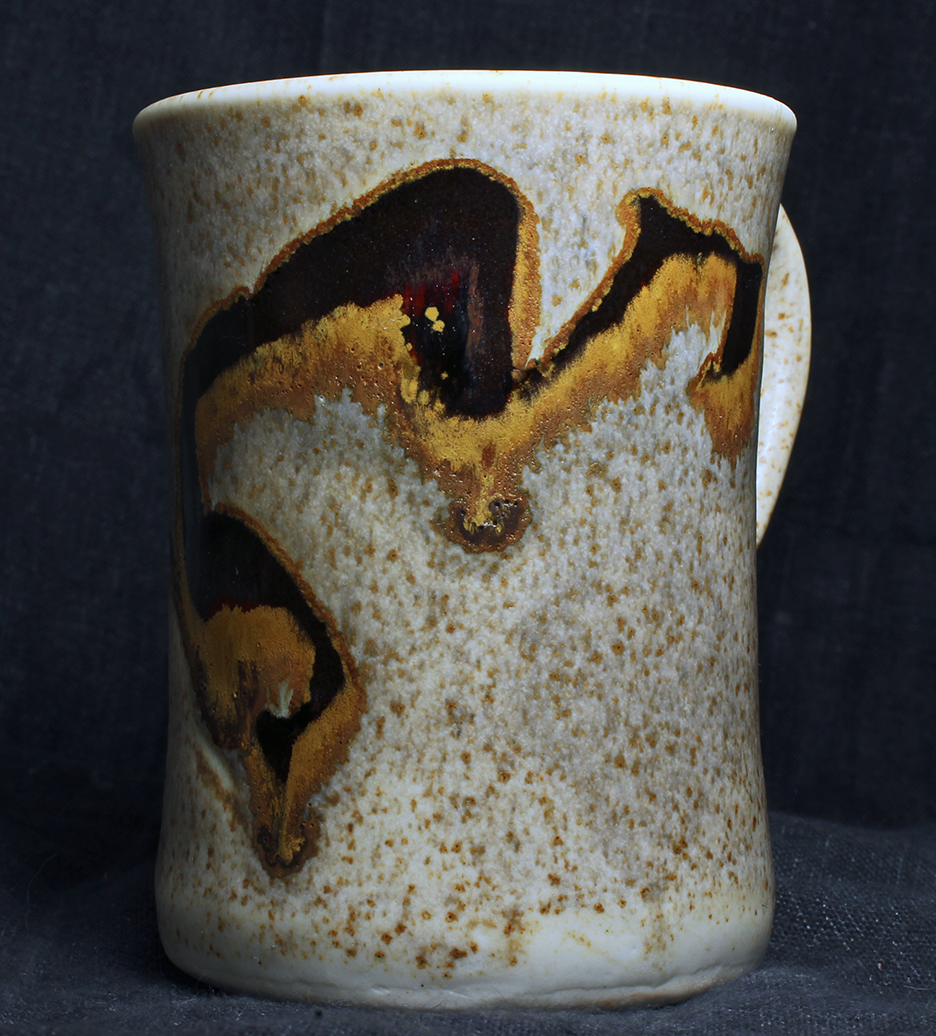One Inlay Glaze
The interface of adjacent glazes.
The interaction region of two glazes. Here I show that two glaze
interaction region with six distinct background glazes;
The foreground design for each mug is glazed with iron_8_R_C10_13PSi.
The design is created by adhering a mask and then applying the main
glaze. After drying, the entire pot is coated in wax,
In each case the interaction is shown on a mug ~4.5 inches in height.
150 deg F an hour to 250 deg F
400 deg F an hour to 1800 deg F
300 deg F an hour to 2050 deg F
120 deg F an hour to 2310 deg F with a hold of 20 minutes at 2310 deg F
300 deg F an hour to 1750 deg F then a half hour hold at 1750 deg F
300 deg F an hour to 1700 deg F then a Three hour hold at 1700 deg F
25 deg F an hour to 1650 deg F then a one hour hold at 1650 deg F
K2O 0.10
Al2O3 0.81
SiO2 4.22
molecular percent Silica 68%
K2O 0.10
Al2O3 0.48
SiO2 3.76
molecular percent Silica 72%
Added:
0.02% Cobalt Carbonate
0.2% Silicon Carbide for local reduction
K2O 0.09
Al2O3 0.4
SiO2 3.63
molecular percent Silica 72%
Added:
0.02% Cobalt Carbonate
0.2% Silicon Carbide added for local reduction
K2O 0.21
Al2O3 0.52
SiO2 2.93
molecular percent Silica 65%
Added:
0.5% copper Carbonate
0.5% Silicon Carbide added for local reduction
K2O 0.21
Al2O3 0.51
SiO2 2.88
molecular percent Silica 65%
Added:
0.5% Silicon Carbide added for local reduction
K2O 0.21
Al2O3 0.56
SiO2 2.77
molecular percent Silica 63.6%
Added:
0.02% Chrome Oxide
0.5% Silicon Carbide added for local reduction
K2O 0.11
Al2O3 0.56
SiO2 3.12
molecular percent Silica 63%
The first background glaze, mashiko_satIron_Z2Q, is a saturated iron glaze with
similar bases as the inlay glaze iron_8_R_C10_13PSi,
The second and third background glazes are celadons. Both have lower alumina
and higher silica than the inlay glaze iron_8_R_C10_13PSi,
The last three background glazes, tsabar-harris-y, tsabar-harris-r, and
tsabar-celadon-PAl are similar glazes, all stiffer than the
each with the same
foreground glaze.
then the mask is removed
and the open area filled in with a second glaze.
Image of the pieces

mug with glaze glaze mashiko_satIron_Z2Q and inlay iron_8_R_C10_13PSi

mug with glaze glaze longquan_n_song_Z2G_0PLi_redart and inlay iron_8_R_C10_13PSi

mug with glaze glaze celedon_PA_Z2G_0PLi_NFe and inlay iron_8_R_C10_13PSi

mug with glaze glaze tsabar-harris-y and inlay iron_8_R_C10_13PSi

mug with glaze glaze tsabar-harris-r and inlay iron_8_R_C10_13PSi

mug with glaze glaze tsabar-harris-celedon-PAl and inlay iron_8_R_C10_13PSi
oxidation firing to cone 10 in an electric kiln
Firing profiles
Up Fire profile
Down Fire Profile
Clay body is a grolleg porcelain from Tacoma Clay Art Center.
glaze compositions
Background glazes
Empirical Formula mashiko_satIron_Z2Q :
Na2O 0.30
Li2O 0.16
CaO 0.20
MgO 0.24
Fe2O3 0.17
P2O5 0.04
Empirical Formula longquan_n_song_Z2G_0PLi_redart :
Na2O 0.13
Li2O 0.09
CaO 0.49
MgO 0.10
ZnO 0.09
Fe2O3 0.015
Empirical Formula celedon_PA_Z2G_0PLi_NFe :
Na2O 0.11
Li2O 0.08
CaO 0.43
MgO 0.21
ZnO 0.08
Empirical Formula tsabar-harris-y :
Na2O 0.07
CaO 0.64
MgO 0.01
SrO 0.07
SnO2 0.05
Empirical Formula tsabar-harris-r :
Na2O 0.07
CaO 0.65
MgO 0.01
ZnO 0.06
Fe2O3 0.02
Empirical Formula tsabar-harris-celedon-PAl :
Na2O 0.07
CaO 0.65
MgO 0.01
ZnO 0.06
Fe2O3 0.01
Inlay Glaze
Empirical Formula iron_8_R_C10_13PSi :
Na2O 0.45
Li2O 0.25
CaO 0.17
MgO 0.02
Fe2O3 0.28
Remarks
yet stiffer than the
inlay glaze as a result of having higher alumina and silica. The resulting
inlay migrates little from its original mask,
nor does it appreciably
diffuse into the matrix glaze.
and thus are
more fluid. The result is greater migration of the inlay, both in downward
flow and diffusion. The second of the two celadons,
celedon_PA_Z2G_0PLi_NFe has higher silica, so is slightly stiffer. The
result the inlay intermixes less with the matrix glaze.
preceding
two celadon glazes. tsabar-celadon-PAl has higher alumina, and is the most
viscous of these three glazes.
The inlay migrates substantially in all
three of these glazes, in a similar manner, showing a narrow
band
of diffusion above the inlay, and a large band, combining both
creep and diffusion, below.